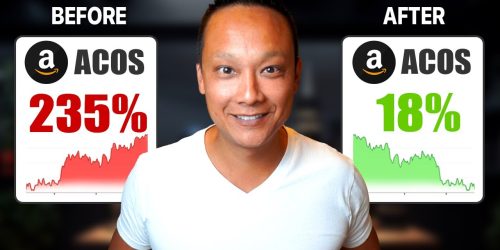How to Set Up Advanced Amazon PPC Campaigns in 2024 | Step By Step Tutorial for Beginners
Amazon PPC (Pay-Per-Click) advertising can be a game-changer for your Amazon business, but it’s also one of the most challenging aspects to master. Without a well-thought-out strategy, you risk burning through your budget without seeing significant returns. In this post, I’ll guide you through setting up advanced Amazon PPC campaigns that can help you achieve winning results, even if you’re just starting out.
Why PPC is Crucial for Your Amazon Success
Understanding why PPC is essential can set the foundation for a successful campaign. Here’s a key insight:
-
70% of All Sales Occur on the First Page: Amazon’s search algorithm primarily ranks listings based on daily sales velocity. This means that listings with higher sales get better rankings. New listings often start on the lower pages because they lack initial sales.
-
PPC Ads to the Rescue: To get your product in front of potential buyers, PPC ads are a powerful tool. These sponsored listings appear at the top of search results, allowing your product to be seen by shoppers even if it doesn’t have sales history yet.
Understanding Amazon PPC Basics
Amazon PPC operates like an auction. Here’s a breakdown of how it works:
-
Auction System: When a shopper searches for a keyword, sellers bid on that keyword. The highest bidder gets the top ad spot. The auction is dynamic, meaning you pay per click, not per impression.
-
Bidding Strategy: Bidding aggressively can help you secure top spots, but it’s essential to understand that you only pay when a shopper clicks on your ad. Setting high bids doesn’t necessarily mean you’ll pay that amount for each click—just that you’re willing to.
Step-by-Step Guide to Setting Up Advanced PPC Campaigns
1. Initial Preparation
Before you start creating campaigns, ensure you have:
- Keyword Lists: Prepare four lists: main keywords, relevant keywords, master keywords, and misspelled keywords.
- Understanding Match Types:
- Exact Match: Shows ads only for the exact keyword phrase.
- Broad Match: Shows ads for variations, including synonyms and related terms.
- Phrase Match: Shows ads for phrases that include your keyword in the exact order but may have additional words.
2. Creating PPC Campaigns
Campaign 1: Exact Match with Main Keywords
- Navigate to Seller Central: Choose
Sponsored Products. - Create Campaign:
- Campaign Name: e.g.,
Tent Stake Main Keywords Exact Match - Targeting Type: Manual
- Keyword List: Paste the main keyword list.
- Bidding: Set a bid $1 above the suggested bid. Use odd numbers to outbid competitors subtly.
- Bid Strategy: Choose
Dynamic Bids - Up and Downfor aggressive campaigns. - Daily Budget: Set to $100 for better exposure.
- Launch Campaign: Review and start.
- Campaign Name: e.g.,
Campaign 2: Exact Match with Relevant Keywords
Repeat the steps from Campaign 1 but use the relevant keywords list. Set the daily budget to $100.
Campaign 3: Broad Match with Master Keywords
- Create Campaign:
- Campaign Name: e.g.,
Tent Stake Master Broad - Targeting Type: Manual
- Keyword List: Use the master list.
- Bidding: Follow the same aggressive bidding strategy.
- Daily Budget: Set to $20.
- Campaign Name: e.g.,
Campaign 4: Broad Match with Misspelled Keywords
- Create Campaign:
- Campaign Name: e.g.,
Tent Stake Misspelled Broad - Targeting Type: Manual
- Keyword List: Use the misspelled list.
- Bidding: Same strategy as before.
- Daily Budget: Set to $10.
- Campaign Name: e.g.,
Campaign 5: Suggested Keywords
- Create Campaign:
- Campaign Name: e.g.,
Tent Stake Suggested Broad - Targeting Type: Manual
- Keyword Targeting: Choose suggested keywords.
- Bidding Strategy: Use
Dynamic Bids - Up and Down. - Daily Budget: Set to $10.
- Campaign Name: e.g.,
Campaign 6: Automatic Targeting
- Create Campaign:
- Campaign Name: e.g.,
Tent Stake Auto - Targeting Type: Automatic
- Bidding Strategy: Use
Dynamic Bids - Up and Down. - Daily Budget: Set to $10.
- Campaign Name: e.g.,
3. Monitoring and Optimization
- Initial Monitoring: Allow campaigns to run for at least 7-10 days to gather sufficient data.
- Analyze Performance: Regularly check which keywords and match types are performing best.
- Optimize: Adjust bids, budgets, and keyword lists based on performance data. Avoid making daily changes—wait until you have enough data to make informed decisions.
Conclusion
Setting up advanced Amazon PPC campaigns involves a strategic approach, detailed planning, and continuous optimization. By following these steps and utilizing aggressive bidding strategies, you can improve your product’s visibility and drive more sales.
For further optimization tips and to dive deeper into analyzing campaign performance, check out this video. Happy advertising!





